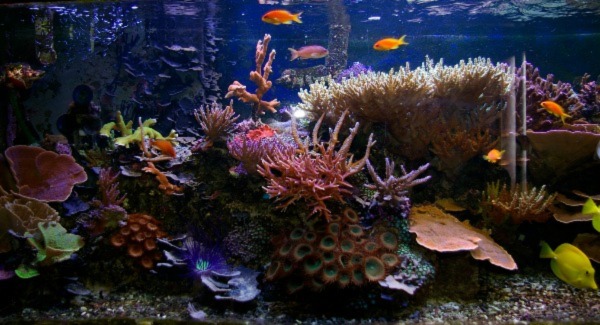Reef Tank Magnesium Levels: How to Raise, Lower & More
Posted by on 12/23/2022
Fact checked by
Magnesium is an essential chemical element that plays a crucial role in the development and functioning of many living organisms. It is the third most abundant element found in seawater and plays an important role in regulating pH.
In this post, we’re going to cover everything you’ll want to know about magnesium in a reef tank. Similar to our phosphate guide, we’ll be discussing some of the best ways to test magnesium levels, how to raise and lower them, and provide guidance on recommended ranges.
December's Giveaways on Light Fish
Magnesium: What Exactly Is It?
Magnesium is a chemical element with the symbol Mg and atomic number 12. It makes up 2.1% of the Earth’s crust and is named after the ancient Greek tribe, the Magnetes . Magnesium has served many purposes throughout our history. It’s played important roles in various industries, including electronics, automotive manufacturing, and aviation.
Magnesium is a vital element for the health of marine organisms in the world's oceans, including coral, algae, and certain types of bacteria. It plays an important role in the synthesis of proteins and other essential biomolecules.
It comes as no surprise that we’ll want to monitor levels of magnesium in our reef tanks, but how exactly can we monitor this dissolved element? Luckily, we have quite a few ways of testing at our disposal.

Best Magnesium Testing Kits
Properly monitoring water chemistry is essential for the success and health of a reef tank. Without accurate testing tools, it would be difficult for aquarists to accurately determine the chemistry levels of their tank's water.
It is important to regularly test and maintain optimal magnesium levels to ensure the well-being of our tank inhabitants. Thankfully, the following test kits make that testing process a breeze!
Marine Magnesium Checker by Hanna
We’re big fans of Hanna, their digital readers are fantastic, and are much easier to use compared to chart-based test kits.
The Marine Magnesium Checker by Hanna is one of our favorites, capable of testing for magnesium ranges from 1,000 to 1,800 PPM. It’s small in size, and easy to use. You can expect to pay around $65 for this checker. It’s battery-powered, but you should get around 5000 tests before having to replace the battery.
Magnesium Pro Test Kit by Red Sea
Experienced reefers are probably familiar with the Red Sea brand, this Israel-based company is known for its popular products such as Reef Energy Plus and Reef Mature.
They offer quite a few different test kits, but we’re big fans of their Magnesium Pro Test Kit . You’ll get about 100 tests from this kit, and it’s accurate within 20 ppm. It’s quite affordable, costing only around $25.
Magnesium Test Kit by Aquaforest
Aquaforest has been in the reef-keeping business since 1995, so it’s no surprise that they offer some of the most reliable test kits around. This company based out of Poland includes a reference solution with their test kit, making it easy to decipher the correct magnesium levels.
Their Magnesium Test Kit should only cost you about $20, you’ll get about 60 tests from this kit.
Magnesium In a Reef Tank
In a reef tank, Magnesium plays an important role. Its buffering capacity is crucial for maintaining proper levels of calcium and alkalinity. If you experience issues with calcium or alkalinity in your reef tank, an imbalance in magnesium may be the cause.
It is important to strive to recreate natural magnesium levels as closely as possible to ensure the health and well-being of your tank inhabitants.
Recommended Ranges
Aim for 1200-1400 ppm of magnesium in a reef tank. High levels of magnesium (above 1500 ppm) can be harmful to snails, clams, and corals, potentially causing bleaching.
On the other hand, low levels of magnesium can also lead to coral bleaching and imbalances in alkalinity and calcium, which can stress and harm the inhabitants of the tank.
How to Lower Magnesium
You can lower magnesium in a reef tank by gradually performing 10% water changes using aquarium salt with a lower concentration of magnesium.
Magnesium levels will also naturally decrease over time, so in some cases, you may be able to simply wait for the levels to naturally adjust.
It is generally not a concern to have high magnesium levels in a reef tank unless there has been an accidental overdose of magnesium. In such cases, it may be necessary to take action to lower the levels.
How to Raise Magnesium
Magnesium levels can be raised by dosing both magnesium chloride (flakes) and magnesium sulfate (salts).
To make a 1-gallon jug of magnesium solution, mix 5 cups of magnesium chloride with 3 cups of magnesium sulfate with reverse osmosis/deionized (RO/DI) water. Then, add small amounts of the solution (less than 1 cup) and re-test your magnesium levels.
It is important to avoid making large changes in magnesium levels (over 100 ppm) in a single day, as this can potentially harm your corals.
Summary
While most aquarists do not encounter any issues with magnesium, it is important to have a good understanding of its importance and to have reliable methods for testing, raising, and lowering magnesium levels.
Now that you have a better understanding of magnesium, it is a good idea to also familiarize yourself with phosphates, another important compound in reef tanks.
We hope you enjoyed this post, if you have any feedback or would like to learn more about the aquarium hobby, we encourage you to visit our community forum or leave a comment below.
December's Giveaways on Light Fish


